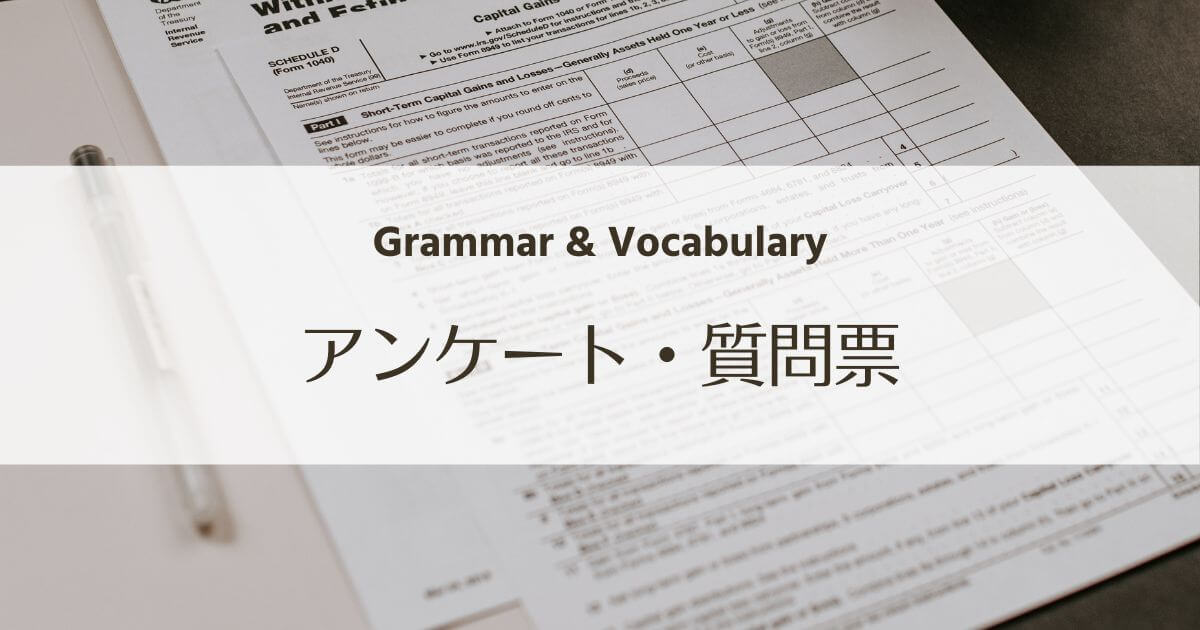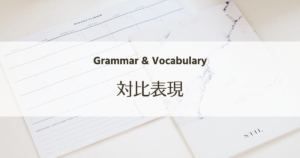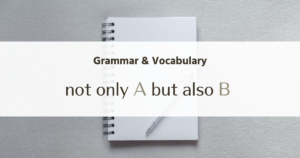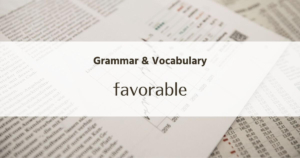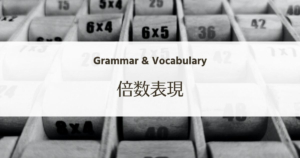アンケートや質問票の回答は、自由記載(非構造化データ)ではなく、数字やカテゴリなどの構造化データで収集することが多いですよね。
今回は、アンケートの質問文や回答などの説明によく使う表現を集めました。
アンケートの作成やデータの集計・発表時などに役立ちますよ。
関連用語
アンケートの内容や方法を説明する際によく使う単語です。下で紹介する例文の中でも使っていますので、使い方もあわせてチェックしてみてください。
- questionnaire:アンケート、質問票
- assess:評価する
- evaluate:評価する
- rate:格付けする(10点満点でいくつかなどの評価)
- item:(質問)項目
- respond:回答する
- response choice:(回答の)選択肢
- score:得点する
- scale:尺度
- self-report:自己申告
- self-administered:自己記入式
例文
質問票の説明
「評価する」という動詞には、assess や evaluate を使います。名詞はそれぞれ、assessment、evaluation です。
This 5-item questionnaire assessed the degree of satisfaction with everyday life.
日常生活への満足度を5項目で評価した。
We evaluated this service using five questions.
このサービスを5つの質問で評価しました。
This questionnaire was used for the qualitative assessment of our service.
サービスの質的評価にこの質問票を使用した。
「定量化する(= quantify)」が適している場合もあります。
We developed this questionnaire to quantify the degree of cognitive function.
認知機能の程度を定量的に把握するために、この質問票を開発しました。
アンケートは自己記入式がほとんどだと思いますが、自己記入式は self-administered と表現します。自己申告は self-report で、これは動詞でも使います。
This is a 15-item, self-administered questionnaire to assess physical function.
身体機能を評価するための15項目の自記式質問紙です。
Participants were asked to fill in the self-reported questionnaire.
参加者には、自己申告式のアンケートに回答してもらった。
回答の選択肢
回答の選択肢は、response choice と表現します。
Each question has four response choices: yes, more or less yes, more or less no, and no.
各質問には、「はい」「どちらかといえばはい」「どちらかといえばいいえ」「いいえ」の4つの回答選択肢があります。
Please respond to the following questions with either yes or no.
以下の質問に対して、「はい」「いいえ」のいずれかでお答えください。
Every participant answered yes to Item 1, “Do you think this service was useful?”
項目1「このサービスは役に立ったと思いますか?」では、すべての参加者が「はい」と回答しています。
点数評価
「X段階の評価で」は、「on a X-point scale」と表現します。
数字ではなく「すき」「ふつう」「きらい」のような三段階の評価の場合も、on a 3-point scale と表せます。
All items were rated on a 5-point scale.
すべての項目は5段階で評価した。
0から10で点数を付けるときは、10段階ではなく11段階になるため気を付けてくださいね。
Please rate the degree of satisfaction for each item on an 11-point scale (0 indicates very dissatisfied and 10 means very satisfied).
各項目について、満足度を11段階(0は非常に不満、10は非常に満足)で評価してください。
「X段階」ではなく「YからZまで」と言いたい時は、「on a scale of Y to Z」と表します。
Patients rated their pain on a scale of 0 to 10.
患者さんは、痛みを0から10のスケールで評価しました。
Each item was rated on a scale of 1 to 5, with 1 indicating the worst and 5 indicating the best.
各項目は1~5で評価され、1が最も悪く、5が最も良いことを示しています。
スコアリング
A total score ranged from 0 to 100, with a higher score indicating a better state.
総得点は0点から100点までで、点数が高いほど良い状態であることを示しています。
A total score is the sum of each item score.
各項目の得点の合計が総得点になります。
In addition to a total score, we also calculated domain scores for the three subdomains.
トータルスコアに加え、3つのサブドメインのドメインスコアも算出しました。

得点
得点は score や point で表します。
Our team got a score of 7 out of 10.
私たちのチームは10点満点中7点でした。
The score of Team A was 6 points higher than that of Team B.
AチームのスコアはBチームより6点高かった。
score は「得点する」という動詞の意味もあります。
Group A scored 75; Group B scored 89.
Aグループは75点、Bグループは89点でした。
He got a full mark on the math exam.
数学の試験で満点を取った。
おわりに
アンケート・質問票の説明で頻出の表現を整理しました。
バリエーションは少ないので、一度覚えてしまえば楽だと思います。
アンケート作成や結果集計の際の参考になれば幸いです。

